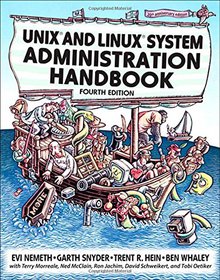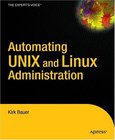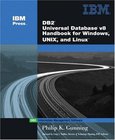UNIX and Linux System Administration Handbook
4th Edition

Book Details:
| Publisher: | Prentice Hall |
| Series: | Prentice Hall , Handbook |
| Author: | Trent R. Hein |
| Edition: | 4 |
| ISBN-10: | 0131480057 |
| ISBN-13: | 9780131480056 |
| Pages: | 1344 |
| Published: | Jul 24 2010 |
| Posted: | Nov 19 2014 |
| Language: | English |
| Book format: | |
| Book size: | 13.53 MB |
Book Description:
'As an author, editor, and publisher, I never paid much attention to the competitionexcept in a few cases. This is one of those cases. The UNIX System Administration Handbook is one of the few books we ever measured ourselves against.' From the Foreword by Tim O'Reilly, founder of O'Reilly Media 'This book is fun and functional as a desktop reference. If you use UNIX and Linux systems, you need this book in your short-reach library. It covers a bit of the systems' history but doesn't bloviate. It's just straightfoward information delivered in colorful and memorable fashion.' Jason A. Nunnelley 'This is a comprehensive guide to the care and feeding of UNIX and Linux systems. The authors present the facts along with seasoned advice and real-world examples. Their perspective on the variations among systems is valuable for anyone who runs a heterogeneous computing facility.' Pat Parseghian The twentieth anniversary edition of the world's best-selling UNIX system administration book has been made even better by adding coverage of the leading Linux distributions: Ubuntu, openSUSE, and RHEL. This book approaches system administration in a practical way and is an invaluable reference for both new administrators and experienced professionals. It details best practices for every facet of system administration, including storage management, network design and administration, email, web hosting, scripting, software configuration management, performance analysis, Windows interoperability, virtualization, DNS, security, management of IT service organizations, and much more. UNIX and Linux System Administration Handbook, Fourth Edition, reflects the current versions of these operating systems: Ubuntu LinuxopenSUSE LinuxRed Hat Enterprise LinuxOracle America Solaris (formerly Sun Solaris)HP HP-UXIBM AIX
Download Link:
Related Books:
Python
For Unix and Linux System Administration
Python is an ideal language for solving problems, especially in Linux and Unix networks. With this pragmatic book, administrators can review various tasks that often occur in the management of these systems, and learn how Python can provide a more efficient and less painful way to handle them. Each chapter in Python for Unix and Linux System Administration presents a particular administrative issue, such as concurrency or data backup, and presents Python solutions through hands-on examples. Once you finish this book, you'll be able to develop your own set of command-line utilities with Python to tackle a wide range of problems. Discover how this language can help you:Read text files and extract information Run tasks concurrently using the threading a...
Automating UNIX and Linux Administration
Wouldnt you like to automate the tedious daily tasks of system administration? Automating UNIX and Linux Administration will show you how, by exploring existing tools and offering real-world examples. Although some of the book is Linux-specific, most of the information applies to any UNIX system, including material on automating tasks across multiple variants of UNIX. Author Kirk Bauer briefly overviews tools and technologiesand assumes preliminary knowledge about editing a configuration file or mounting a file system. The techniques, methods, and tools in this book will help you manage a single systembut will prove especially powerful across multiple systems. No matter if the systems are desktops, servers, or Beowulf clustersall of them will benefi...
DB2 Universal Database V8 Handbook
For Windows, UNIX and Linux
IBM DB2 Universal Database V8 offers breakthrough availability, manageability, performance, and scalability. Now, straight from IBM, there's a start-to-finish guide to DB2 Universal Database V8 administration and development for UNIX, Linux, and Windows.This definitive reference covers every aspect of deploying and managing DB2 Universal Database V8, including database design for optimal performance, availability, and recoverability; day-to-day administration and backup; comparing, selecting, and using appropriate DB2 programming techniques; deploying networked and Internet-centered database applications; migrating to DB2 UDB from other databases or earlier versions of DB2; and much more.Using real-world examples, this book shows how to take full adv...
2007 - 2021 © eBooks-IT.org



